| section Home
Production, Amateur Radio amateur Model aircraft, rocket- Useful, entertaining |
Stealth master
Electronics Physics Technologies invention |
space Mystery
Earth Mysteries Secrets of the Ocean Stealth section Map |
|
| Use of material is permitted for reference (for websites - hyperlinks) | |||
Navigation: => |
Home / Products Patents / In the section of the catalog / back / |
|
INVENTION
Patent of the Russian Federation RU2278228
![]()
METHOD FOR STRENGTHENING BOSSES
The name of the inventor: Mark Nadinsky (RU); Nadinskiy Vladimir Markovich
The name of the patent owner: Nadinsky Mark Nikolaevich (RU); Nadinskiy Vladimir Markovich
Address for correspondence: 144003, Moscow Region, Elektrostal, Lenin Avenue, 43, Apt. 47, M.N. Nadia
Date of commencement of the patent: 2004.06.24
The invention relates to the field of construction, in particular to a method for fixing wooden coverings. The technical result of the invention is to provide a dense, without cracks coating, increasing its strength and durability. The method of fastening the boards or panels includes making grooves in the boards or panels, gluing boards or panels along the sides, placing in each recess a fastening profile with a groove and then pressing the boards or panels laterally through elastic elements supported by the frame members and fixing Fastening through a groove of boards or panels to a skeleton. The gripping part of the fastening profile - the shelf - is placed in the recess of the boards or panels, and the lower part of the fastening profile having a groove is placed in the recess of the frame, forming between the fixing profile and the fastening position of the gap, with the connection of the boards or panels with the frame being elastically dosed.
DESCRIPTION OF THE INVENTION
The invention relates to the construction of houses, structures of household blocks, wood products, or more precisely for the manufacture and finishing of boards, panels of boards: floors, walls, ceilings and wooden products.
There is a known method of fastening boards to the frame, lagging nails, that is, flashing boards through the thickness or through the edge (see AM Shepelev, Repair of the apartment with their own hands., Moscow, Moscow Worker, 1979).
This traditional method of fixing boards has the following drawbacks. The boards are rigidly fixed with nails on the logs, and when the boards dry up, crevices are formed.
Puttying requires additional means of labor. Frequent repairs are inevitable. The presence of hammer nails on the surface of the boards is not aesthetically pleasing.
The boards dry up during operation, their sizes decrease, the gaps increase between the boards, and with increasing humidity the dimensions increase. All this leads to warping of the boards.
Of the known methods of fastening the boards, the closest to the technical essence is the method of fastening the boards in the manufacture of floors, walls, ceilings according to RU Patent No. 2221121, E 04 F 13/10. This method does not cover other types of fastening boards without cracks. This method includes the operations of drilling the transverse holes in the boards, passing screeds through them, installing elastic elements with nuts and washers at the ends of the ties, characterized in that grooves are placed in the coaxial holes in the boards in which arches and fasteners are installed on the screeds with a lateral clearance for drying out , The boards are glued together, but before that, through the arches of the boards fix the fasteners on the frame. The grooves under the arc can be made on the frame.
In this way, relatively thin boards can not be fixed, since the transverse holes in the boards and grooves noticeably weaken the cross sections of the boards, which in some cases is unacceptable. The method complicates the production of coatings by drilling through holes in the boards, the manufacture of screeds and fasteners on screeds, assembly on screeds.
The object of the present invention is to provide a simpler manufacturing method, fastening the boards to the frame, allowing to assemble dense floors, walls, ceilings and other floorings from any boards, assortments and from thinner boards, without weakening the strength of the boards. The method provides a permanently tight gap-free connection of these boards.
The foregoing task is achieved by the fact that in the proposed fixing method, in the manufacture of floors, walls, ceilings, decking, cross-sectional through holes in the boards are not performed, no screeds are applied. The boards to the floor are pressed according to one of the proposed solutions. The boards are connected to each other and can be pressed by elastic elements installed on both sides of the deck. The boards can be glued along the sides.
The stated task is achieved by the fact that in this application for the method of fastening boards, solutions have been developed in which boards or boards of boards are firmly connected to each other and are "floating" within the dimensions of drying and swelling of wood, are connected to the frame by fastening profiles and the like, Connecting them to the skeleton and allowing you to shift to a predetermined value, for example, when shrinking and moistening the boards themselves and the frame.
This method achieves a constant density of the flooring, that is, the absence of crevices between the boards, the increase in strength, reliability, durability of the coating, and as a result, environmental friendliness, aesthetics is improved, and the density of planks is achieved among themselves. The non-rigid connection of them to the base, the frame provides a limited, calculated movement of the boards.
The proposed methods are an evolution of the direction of the methods presented in the patent RU No. 2221121, which is a prototype of this.
Grooves that allow the boards to move when they shrink and swell can be made in the boards themselves, in sections of boards, in fasteners, in fastening profiles, in guides, in frame elements, in the frame itself. Depending on the amount of shrinkage, wetting, and the size of the plank coating, the dimensions of the grooves along the length and width are determined by calculation and accordingly one of the process variants is selected. For large decks, longitudinal grooves and transverse grooves of the appropriate size are provided for and in the frame members. The shelves of the fastening profiles can be located on the thickness of the board, on the front side of the board, and on the opposite side with respect to the front. To place the mounting profiles in the boards in the frame, appropriate grooves are made, and grooves for moving the boards within the grooves.
Floorings from the sides along the width, and sometimes along the length from the ends, are compressed by elastic elements. This way it is possible to cover large areas with a dense flooring of boards, which will remain dense for the entire period of its use. It is possible to make the coating "floating" in this way without pressing the sides with the elements.
Dense connection of boards, boards from boards is possible with a parquet, with pressing and gluing along the lateral surfaces and non-rigid through grooves, plinths, fastening, tightening them to the base, the skeleton allows to achieve dense, more durable, durable flooring. Improves aesthetics, ecological compatibility, tightness of the coating. The quality characteristics of the coating are improved. Execution of finishing operations, including the application of paints and varnishes, is possible in the production environment, which increases the productivity of those engaged in these operations and improves the quality, as it is performed in a specialized modern enterprise.
The following are specific examples of the invention, with reference to the accompanying drawings, which show the fastening of boards and panels to a frame:
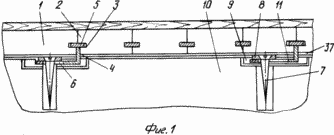 |
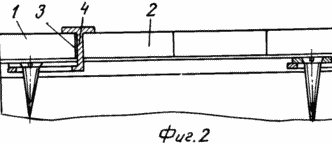 |
 |
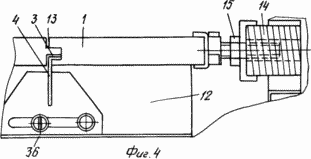 |
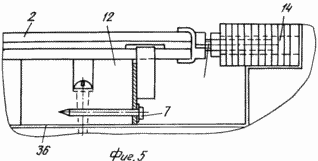 |
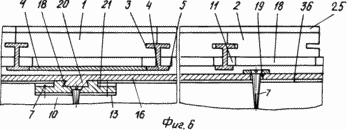 |
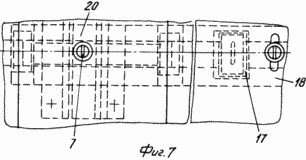 |
 |
 |
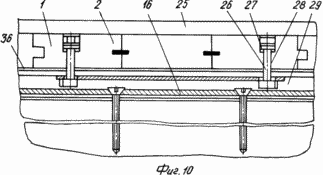 |
 |
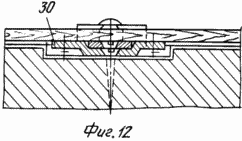 |
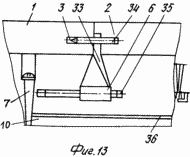 |
Figures 1, 2, 3 - through the grooves of the fastening profiles; FIGS. 4, 5 - with pressing of elastic elements from the sides and from the ends; 6, 7 - through the transverse and longitudinal grooves of the guides; Fig. 8, 9 - through grooves of sheet piling profiles - laths; Fig. 10 - through fasteners in the grooves of the carcass guides; 11, 12 - stripes through staples; 13 with sliding fastening. |
In all embodiments of the method, it is possible for boards or panels of boards to move relative to the frame in transverse and longitudinal directions, for example, when shrinking and moistening the wood.
The method of fastening boards, boards of boards, other timber assortment, excluding the formation of slots, can be performed in several ways or by their combinations:
1. Figures 1, 2, 3 in the boards 1, 2, 3. In the boards 1 or 2 before assembly, before the gluing, the recesses 3 of the fastening profiles 4 and their shelves 5 are made, grooves 6 are made. In the recesses 3, the fastening profiles 4 with the shelves 5 are installed. The boards 1 , The panels 2 with fixing profiles 4 are fixed through the grooves 6 with a fastener 7 which rests on the strips or washers 8. The lower part of the fastening profile 4 having the slots 6 is located in the recesses 9 of the frame 10. The recesses 9 can be executed in the boards 1, 2, in the frame members 10, so that there is a gap 11 between the fixing profile 4 and the fastening point with the elastically-pressed boards 1, for example, to the frame 10. and the following boards 1, panels 2 are installed and fixed. It turns out to be elastically pressed, Floating in preset values of a coating of boards, panels.
2. FIGS. 4, 5. On the boards 1, on the panel 2, before fixing the fixing profiles 4, adhesive 13 is applied to the side surfaces. The fastening 7 is made on the side surfaces of the log laths 12. By strengthening the boards on the bars 12, panels 2 are obtained which are mounted on Skeleton 10, fasten the bars with the fastener 7 on the frame 10, connect the other panels 2 and press them laterally with the necessary force through the elastic elements 14, for example, screw pairs 15 or devices of a similar purpose. The support for screw pairs 15 and elastic elements in these cases is the frame 10. When laying long coatings from boards 1 of panels 2, they are glued along the length by glue 13 and pressed along the ends, as shown in FIG. 5, through elastic elements 14 by devices of a similar purpose 15 It is possible to fix the bars 12 to the frame 10 with glue 13.
3. FIGS. 6, 7. The boards 1 or panels 2 are joined by fixing profiles 4 with transverse guides 16, heating the lower shelves 5 of the fastening profiles 4 in the slots 17 of the shelves 18 of the guides 16. Either fix the guides 16 through the slots 19 with the fastener 7 with the frame 10. It is possible, with long decking, to mount transverse guides 16 with projections 20 in the slots 18 of the longitudinal guides 21, which are connected by fasteners 7 or glue 13 to the frame 10.
4. Fig. 8, 9. On the boards 1, the panels 2 carry grooves with the hangers 22, grooves 6 are formed on the slats profiles 23. Through the grooves 6 and the grooves 22, the boards 1, the panels 2, glued along the lateral surfaces 24 Glue 13, with a frame 10, and are urged by the screw pairs 15 through the elastic members 14.
5. FIG. The boards 1 or panels 2 without a parquet or with a parquet 25 are fastened in pairs by a pair of fasteners 26, through the elastic members 27 and through holes with the shelves 28 in the concealed slots 29 of the cross rails 16.
6. Fig. 11, 12. The brackets 30 together with the strips 31 are fastened to the underside of the boards 1, the panels 2. The strips 31 are fastened to the carcass by fastening 7. The boards 1 and the panels 2 are urged by the screw pairs 15 through the elastic elements 14. The screw The pairs 15 can be the protrusions 32 of the strips 31 or the carcass 10.
7. The pin 34 is fixed in the side parts of the boards 1 or panels 2, a fastening profile 33 is put on it, which is fastened through the groove 6 or protrusion elasticly with freedom of movement by the bracket 35 in the side of the bar 12. The bars 12 are fastened to the frame by fastening 7 or glue 13 .
Depending on the frame material, boards and requirements, a waterproofing material 36 and, for example, a polymer film 37 are placed between the frame and the boards.
According to the above embodiments and the like, according to this method, it is possible to move boards 1 and panels 2 along and across. The elastic-dosed boards 1 and panels 2 are pulled to the frame with a certain force to be fastened to the frame 10. Elastic pressing of the boards 1, panels 2 from the sides and from the ends ensures reliable adhesion and improves the displacement conditions when shrinking or moistening the wood.
The grooves in the transverse and longitudinal directions of the flooring are calculated by the shrinkage factor in accordance with GOST 164838-71.
In many other cases, in the floors, walls, ceilings, decking with rigid attachment to the frame between the boards, crevices are formed, as the wood shrinks in width and length and thickness of the boards.
This way of fixing provides a selection of gaps "floating" floors and other coatings and the exclusion of the formation of gaps between the boards.
The effort of squeezing boards and panels from the sides and ends through elastic elements in a simplified form can be calculated by the formula:
P> P 1 · F,
Where P 1 - the total force of the preload of boards to the frame;
F is the total coefficient of friction between the boards and the frame.
To avoid the opening of the slots, the compressive force P o is equal to:
P o > P 1 · F + P k ,
Where P k is the force that occurs when the boards are warped.
The size of the boards pressing from the sides by a screw pair through the elastic elements is determined based on the size of the coating, the shrinkage coefficient of the board material, bars, frame, based on operating conditions and coating material characteristics.
In some cases, after gluing boards and panels along the side surfaces of the device, the pressing boards from the sides and ends can be removed.
Planks, panels, a frame, guides, fasteners protect from influence of an atmospheric moisture and other phenomena leading to destruction.
The claimed invention, in comparison with the known ones, allows:
- significantly simplify the fastening of boards, panels between themselves and to the frame with the provision of a solid without cracks of the flooring;
- eliminate the weakening of the section of boards, panels, caused by drilling holes for screeds;
- ensure the fastening of thinner boards, thinner than 12 mm, without cracks;
- prevent the warping of boards in decking;
- To reduce the time of manufacturing the coating from boards, panels, parquet many times;
- Reduce the cost of coatings from boards, panels, parquet;
- to make fully finished industrial varnishes painted with varnish, paint boards, panels, decking and with parquet, to assemble in a short time with high quality without using the labor of highly qualified specialists;
- to achieve the best value for the buyer value - price x quality.
CLAIM
A method for fastening boards or panels, comprising making holes in boards or panels, gluing boards or panels along the sides, placing a fastening profile with a groove in each recess and then pressing the boards or panels laterally through elastic elements supported by the frame members, And fixing, through the groove, the boards or panels to the frame, characterized in that the gripping part of the fastening profile-the shelf-is placed in the recess of the boards or panels, and the lower part of the fastening profile having a groove is placed in the recess of the carcass with the formation between the fastening profile and the fastening position Gap, while the connection of boards or panels with a frame is carried out elastically.
print version
Publication date 21.01.2007gg




Comments
Commenting, keep in mind that the content and the tone of your messages can hurt the feelings of real people, show respect and tolerance to his interlocutors, even if you do not share their opinion, your behavior in terms of freedom of speech and anonymity offered by the Internet, is changing not only virtual, but real world. All comments are hidden from the index, spam control.